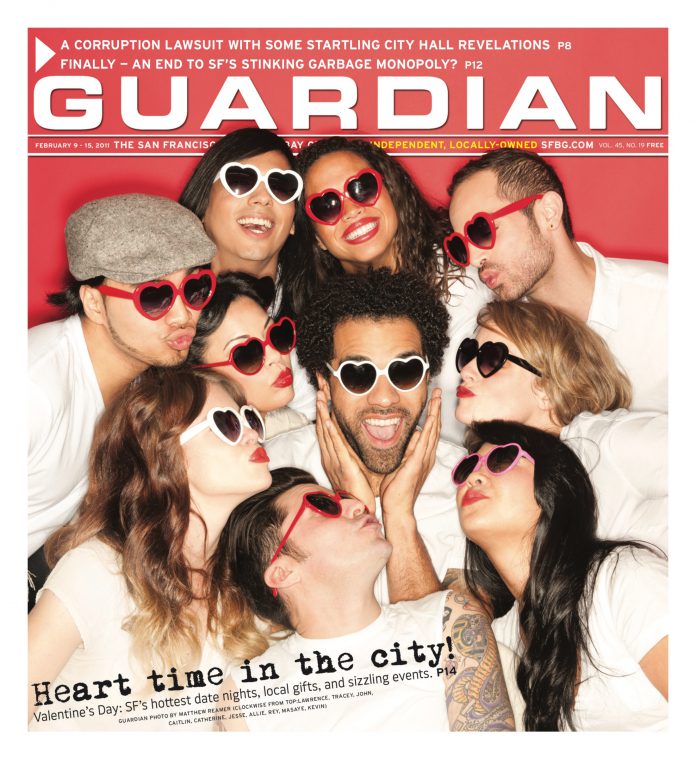arts@sfbg.com
DANCE There is a guy in town named Jess Curtis who has the most gorgeous mop of white hair and a smile to match. His body is taut and muscular; it also shows signs of wear from working hard and probably playing hard. Curtis used to be part of the now-legendary Contraband, for a while the most radically inventive dance troupe in the country. Then he and his buddy Keith Hennessy took off for France where the ministry of culture — anybody listening at the NEA? — set up a special, nicely funded section for Circus Arts. This should have made red-blooded Americans recoil in horror. Instead it invigorated the two guys’ ideas about performance and its role in society. Above all, they got in closer touch with their own bodies and how they wanted to use them.
Coming back, Curtis took off for Davis (Hennessy was to follow), the former agricultural college, now a production line for the Bay Area’s starving dancers, who want to acquire (a wee bit of) wealth, wisdom, and perhaps a job in a university. A body-based, anarchical perspective, so integral to the critical theory thriving in academia, also generally opened a universe for dance, which for so long had been intellectually suspect because it had no “text” that could be studied, analyzed, and turned into a dissertation.
For Curtis, a socially committed artist since his Contraband days, who wants his work to at least chip away at the conflicts, prejudices, and histories that divide us, body-focused thinking was a good place to start. The body, after all, is all we have; it’s our home and our hell. As artistic inspiration, the idea is not new. Take one look at Picasso, and you see a patriarchal guy obsessed with the human female body.
Along comes Dances for Non/Fictional Bodies, Jess Curtis/Gravity’s two-hour extravaganza for six artists — Curtis, Claire Cunningham, Matthias Hermann, Jörg Muller, Maria Francesca Scaroni, and Bridge Markland — who keep shifting and revealing new sides of who they are or might be. It’s a fun game to see how new individual “fictional bodies” pop up like corks from what sometimes is a morass of images and information. that in turn fatigue, delight, and surprise. This stripping away and putting on of new identities is often accomplished by changes in attire. (PhD dissertation, anyone?).
Dances lives off the talents of its protean performers. Muller, who under his Red Riding Hood outfit hides a rabbit in his crotch (take that, Freud), levitates so that an object can scoot under his horizontally-stretched body. Curtis passes out philosophical treatises but creates another type of enlightenment by engaging in what amounts to a 20-mile stationary bike ride to illuminate a string of holiday lights. Scaroni dons a fat suit and dumpy clothes yet turns herself into an elegant roller skating virtuoso. She’s also a karaoke singer and, with the help of Mueller, a cross-dresser.
My favorite chameleon, however, was Cunningham, whose dainty feet and delicate fingers use crutches as pincers. For much of the first half, she scoots around like a Roomba, busily rearranging props and — if I saw correctly — audience members. In the end, donning a red boxing outfit and sitting in a bathtub, she reveals herself as a soprano, delivering a respectable Bach aria.
For all its embrace of egalitarianism and plenitude, to the extent that Dances works it is because of the care and shape-shifting craft that these artists imposed on a rich mix of physical props, performance ideas, and individual talents. Like it or not, this is an elite collection of performers. During the post-show discussion, Curtis explained that artist-activist Guillermo Gómez-Peña, who was present, had been helpful with Dances‘ timing. It became quickly evident that Gómez-Peña does not want to be a consultant; he wants to join the circus.
DANCES FOR NON/FICTIONAL BODIES (COMMUNITY CHORUS INSTALLATIONS)
Thu/10, noon–2 p.m.; free
Yerba Buena Gardens
Third and Howard, SF
(415) 978-2787

